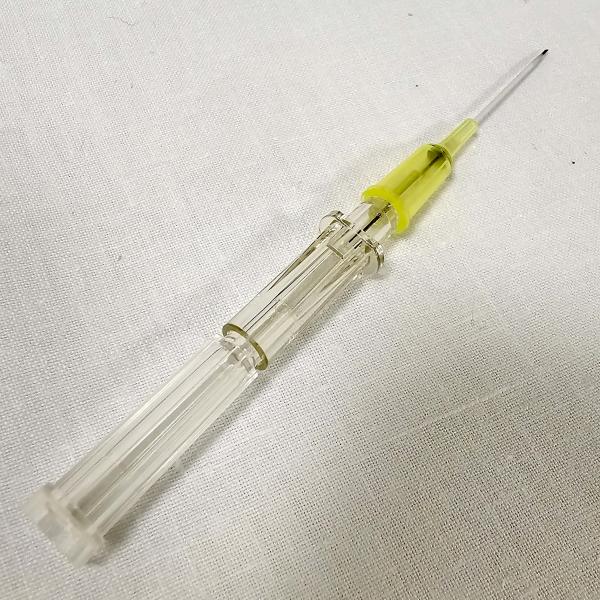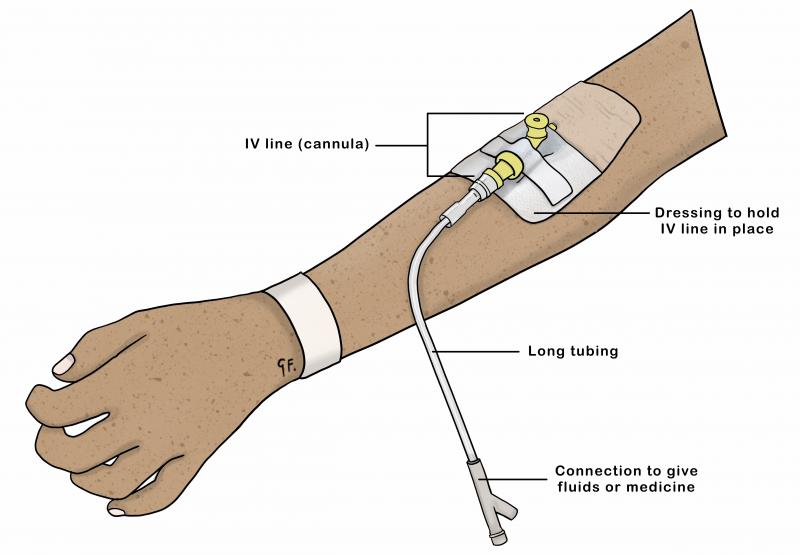IV Line (Cannula)
IV Line (Cannula)
An intravenous line (IV line) is a short, small plastic tube that the healthcare team may put into your child's vein using a needle. They remove the needle and leave the plastic tube in place so they can use medicines to treat your child.
What is an IV line?
An IV line is sometimes known as a cannula.
It's a short, small plastic tube with a needle inside.

A member of the healthcare team will put the IV line into your child's vein.
They will take the needle out and leave the plastic tube in so they can use medicines to treat your child.

Sometimes, a doctor or nurse may take blood samples from the IV line.

Why would my child need an IV line?
The IV line will allow your child's medicine to go directly into their vein.
Your child will have an IV line if they are too sick to swallow medicine or if it is the best way to give medicine.
How will they put the IV line in?
Putting on numbing cream
The doctor or nurse may first put a numbing cream on your child’s skin. It takes about 30 to 60 minutes for the numbing cream to work. If your child needs an IV line urgently, there may not be time to put on numbing cream.
Putting in the IV line
A doctor or nurse will use a tight band (tourniquet) around your child's arm or leg.
Your child will need to be still while the IV line is put into their vein. The healthcare team will help you comfort and hold your child.
A child's veins are quite small and the doctor or nurse may need to try several veins to get the IV line in place. Putting the IV line in can hurt.
Once the IV line is in the vein, the doctor or nurse will take out the needle, leaving the plastic tube in. Tape and bandages will hold the plastic tube in place.
Your child may have a padded board (splint) to keep their hand or foot still.
Taking blood tests
The doctor or nurse may take blood tests from the IV line when they are putting it in. If they cannot collect enough blood from the IV line, your child may need a separate blood test.
How will my child receive medicine?
A doctor or nurse will attach long tubing or syringes to the IV line to give the medicine. Often, the doctor or nurse will put long tubing into a special (IV) pump. It controls the amount of medicine that will go in.
Your child's healthcare team will discuss with you how long the IV line needs to stay in. This will depend on why your child is having the IV line, and how quickly they get better.
What problems can happen with IV lines?
IV lines can block, leak or become infected. The healthcare team will regularly check the IV line and the area around it. They will look for redness, swelling, leakage and pain where the IV line goes in. Sometimes, they may need to put a new IV line in another place. There can be a bruise around where the IV line was. This will soon fade.
If you are worried, please ask the healthcare team to check your child's IV line.
What can I do to help my child while they are having an IV line put in?
You can comfort your child by staying with them as the IV line is put in.
It is helpful to distract your child by cuddling, telling stories, singing or playing with a toy or game. Try to remain calm and comfort your child. Praise your child afterwards - putting in an IV line is not easy for a child.
The staff are there to help you and your child. If you would like more information, please ask the healthcare team caring for your child.
This page last reviewed 14 November 2023.
Do you have any feedback for KidsHealth?
If you have any feedback about the KidsHealth website, or have a suggestion for new content, please get in touch with us.
Email us now
